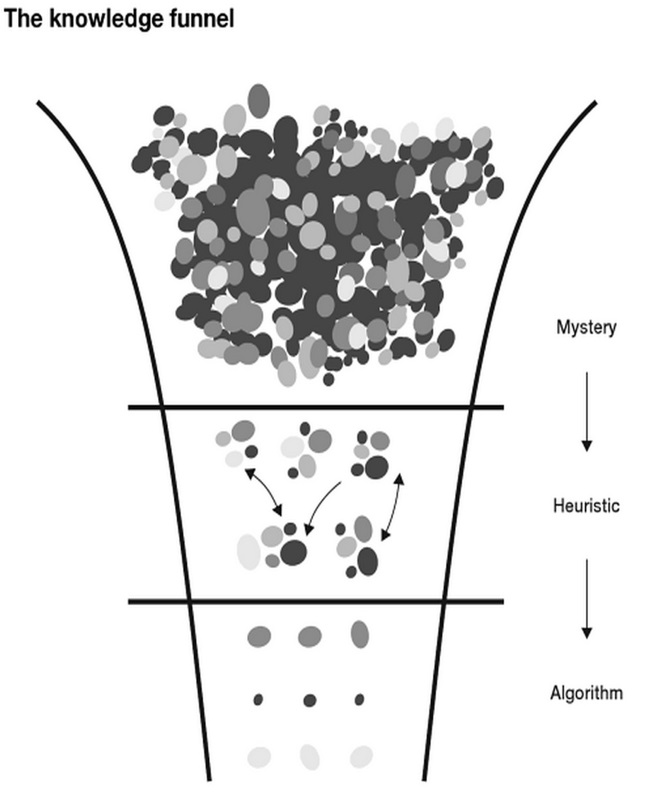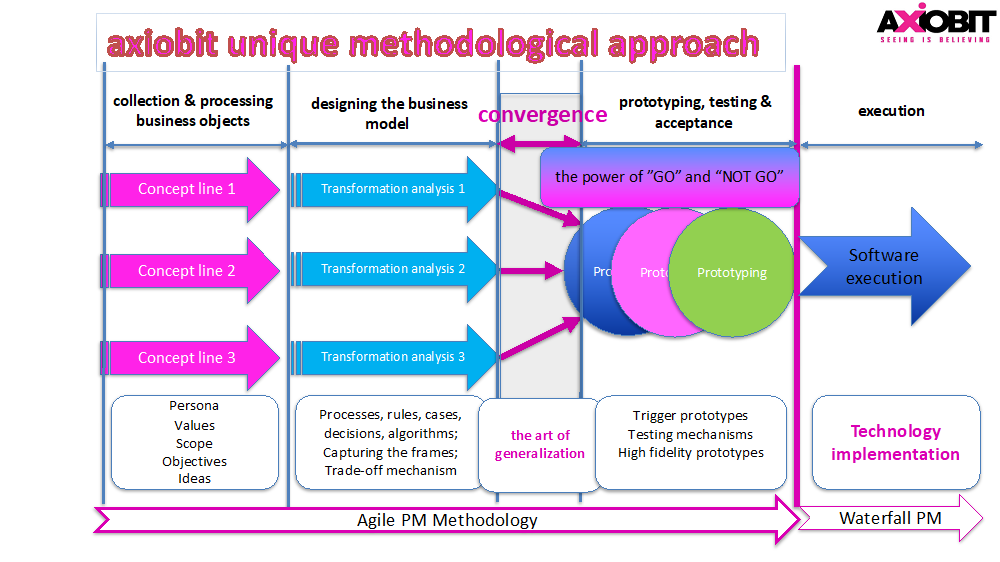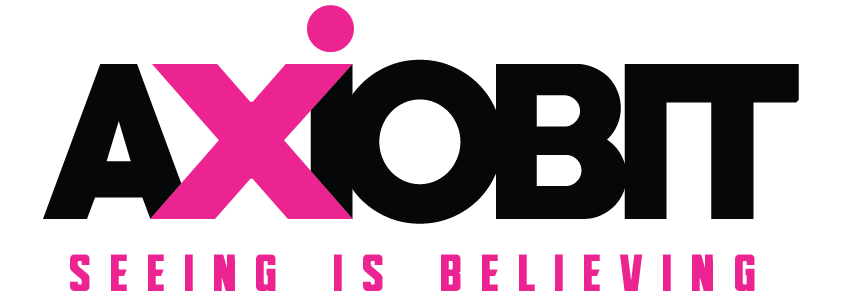Describe the tongue of the woodpecker! Leonardo da Vinci, Notes (to-do-list) 1490.
Introduction. Conventionally, digital business projects are limited to transposing the existent knowledge into a digital format in order to get more transparency and some automated features. In many situations this limited scope cannot create value. Therefore, it is a large amount of failure within the digital business realm. Statistics shows that more than 70% of the digital initiatives fail. Experience shows that more than 90% of the problems that are related to business analysis fail. The lack of a scope defined creates communication issues. Consequently, communication issues create inconsistencies.
A point of clarity is that the digital initiatives should change their scope. And this about changing the methodology.
Digital initiatives are not about technology. They are about knowledge creation.
The knowledge funnel. The idea of the relationship between the knowledge funnel and business was coined by Roger Martin in his seminal work Design of Business.

- The first stage of the funnel is the exploration of a mystery. From the business perspective, the focus is more on business objects without any explicit relationship among them. Having the scope in mind the object definition is compulsory required.
- The next stage of the funnel is a heuristic. The heuristic may be a set of processes, rules and decisions that may connect in a business rational way the business objects that were previously defined. It is a way of thinking about the mystery that provides a simplified understanding of it and allows heuristic creators to focus their efforts. It is the initial creation of business models.
- “Algorithms are certified production processes. They guarantee that, in the absence of intervention or complete anomaly, following the sequence of steps they embody will produce a particular result ensuring the success of the entire approach.” (Roger Martin)
The knowledge funnel is a great visual description of the process of building knowledge. It should be the basis of all innovation initiatives today; together with the necessary understanding that human beings are transformed in terms of the way they perceive and interpret realities.
The parallel methodologies: ITIL, Big4 & Co. The classical methods of business analysis fail in generating implementation algorithms. They might be responsible for problems in digital business initiatives. They neglect the mystery zone and do not give any image about required convergences that define algorithms. These methodologies are promoted by experts who pretend they know the algorithms before exploring the mystery zone and before creating heuristics.
During the last years, the business consulting work based on classical methods has not produced reliable results. It is the immediate result of maintaining text-based consulting work and neglecting the transformation of human being.
Design thinking and its limitations. As long as the classical business analysis methodologies neglect the mystery in any consulting venture, moving straight to an illusory and, in most of the cases, incorrect algorithm, design thinking methodology does not take into account the heuristics zone of the knowledge funnel. The elements of the business model (such as processes, rules, decisions and cases) are missing. Moreover, the short version of the design thinking (sprint design) is just a business bubble; the rate of success in terms of sustaining innovation is insignificant.
The methodology of convergence. The methodology aims to combine technicalities of the mystery and heuristics zones of the funnel with the art of convergence required for creating a visual algorithm that might be validated for the future production process. The convergence method is the transition from the parallel consulting that aims to define business objects and the relationships among them to the visual digital prototype. Only the (high definition) prototype can allow logical leaps for knowledge development and validated improvements.

The logical leaps are human processes that create the visual and psychological circumstances for the improvement of knowledge that create real business development. They are the only sustainable innovation assets.
The convergence methodology covers the entire spectrum of zones related to the knowledge funnel and impacts (at least) three project domains:
- Project management approach. In software projects there are two main schools of project management that debate related to planning and human interaction: waterfall (classical approach) and agile (a new wave). Both are well structured approaches. However, in implementing digital initiatives where there are two main stages (business analysis and IT execution) the methods fail if they are treated separately. The convergent methodology is proposing how to use both methods in order to create performance. Based on an extensive experience our team observed that the agile method is more appropriate for the initial stages of the project (until the high-fidelity prototype is delivered and validated). For the IT execution the waterfall method is more functional.
- Minimum viable product. The concept was described as being a version of a product that can satisfy the client’s requirements and provide feedback for the future by Eric Ries and Steve Blank. However, MVP has not been satisfactory, and the creation has proven as being costly (in many cases extremely costly). Today, more and more, MVP is replaced by prototypes (usually a high-fidelity one) that are related to building knowledge more than technology ability. As a matter of fact, the concept of minimum viable product has not kept its promise of creating a lean approach.
- Complexity processor. The continuous production of visual artefacts creates the best method to simplify the complexity of the context. The complexity is done by the environment and by the exceptional situations in which the user is exposed. The convergent methodology allows the logical transfer of the exceptionalities to rule-based situations.
- User’s story collection method. Convergent methodology proposes a change in story collections from personas interviews to dynamic “naming and framing” sessions based on structured discussions and tradeoffs. Naming and framing is the core of the deliberative dialogue.
Concluding thoughts. The convergent methodology for business analysis in digital initiatives is based on the present-day transformation of the environment, people, technology and knowledge. It aims to create a success framework for IT execution, money savings, simplification of the input complexity and a better response to disruptive businesses and technologies.
Axiobit Limited is a group of experienced consultants who has developed an original business understanding around the idea that the key of innovation (and imagination) is the ability to make connections across disciplines: arts and sciences, humanities and technology. Based on what we know this is the only way to build value. Based on the methodology of convergence, the people at Axiobit have imagined, created and supported IT implementations for various industries and topics. The consultants supported our customers to understand the meaning of performance and capacity, the refined scope of engaging customers within communities, etc.
